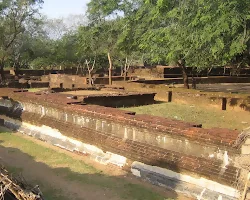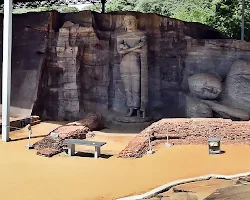
Located in the North Central Province of Sri Lanka, stands as a testament to the rich cultural heritage and architectural brilliance of the island nation. Established as the second capital of Sri Lanka, Polonnaruwa thrived between the 10th and 13th centuries AD, following the decline of Anuradhapura. The city’s historical significance, together with its well-preserved ruins, attracts numerous visitors and historians alike. This article delves into the history, architecture, culture, and significance of Polonnaruwa, chronicling its rise, golden era, and eventual decline.
It’s historical roots date back to the 4th century BC when it was known as Thivanka Nagara. However, it rose to prominence as the capital during the reign of King Vijayabahu I in the late 11th century AD. He established it as the capital in 1070 AD, primarily due to its strategic location, providing better protection against potential invasions from South India.

Polonnaruwa experienced its golden era under the reign of King Parakramabahu I (1153-1186 AD), one of the most illustrious monarchs in Sri Lankan history. He was a visionary ruler who focused on developing the city’s infrastructure, agriculture, and cultural aspects. King Parakramabahu I constructed vast irrigation systems, including the massive Parakrama Samudra (Sea of Parakrama), a colossal man-made reservoir that even today remains an engineering marvel.
The city’s architecture also flourished during this period, with grand structures such as the Royal Palace, audience halls, temples, and stupas being built. The most iconic among them is the Rankoth Vehera, an awe-inspiring stupa adorned with intricate carvings and surrounded by smaller stupas.
The period of King Parakramabahu I’s rule also witnessed a cultural renaissance in Polonnaruwa. Scholars, poets, and artists thrived, and the city became a hub of intellectual and artistic exchange. Buddhist learning and teachings prospered, and the construction of various Buddhist monasteries and temples enriched the religious landscape of the city.
The Gal Vihara, a set of four magnificent Buddha statues carved out of a single granite rock, stands as a masterpiece of ancient Sri Lankan sculptural art. These statues, depicting the Buddha in different poses, exemplify the artistic achievements of the time.
Despite its golden era, It eventually faced challenges from external forces, including invasions from the Chola dynasty of South India. King Nissanka Malla’s reign (1187-1196 AD) marked the beginning of the city’s decline. Although he made significant contributions to Polonnaruwa’s architecture, the frequent invasions weakened the city’s defenses and drained its resources.
By the late 13th century, it’s glory had faded, and the city was abandoned as the capital, paving the way for the rise of Dambadeniya as the next political center in Sri Lanka.

In the centuries that followed, it’s ruins were left to the mercy of time and nature, and much of the city was concealed by dense forests. However, during the British colonial era, efforts were made to uncover and conserve the archaeological treasures of Polonnaruwa. In 1982, the site was recognized as a UNESCO World Heritage Site, acknowledging its immense historical and cultural value.
Today, it’s well-preserved ruins attract travelers from around the world, offering a glimpse into the grandeur of the past. The ancient city is divided into several areas, each housing distinct architectural wonders:
It is not only a tourist destination but also a symbol of Sri Lanka’s cultural heritage. The ancient city holds immense religious significance for Buddhists as a place that played a vital role in the propagation and preservation of Buddhism. The architectural and artistic achievements of Polonnaruwa reflect the advanced civilization that thrived in ancient Sri Lanka.
The ancient city of Polonnaruwa stands as a treasure trove of history and culture, encapsulating the brilliance of ancient Sri Lanka’s civilization. From the golden era of King Parakramabahu I to its eventual decline, the city’s journey is one of grandeur and challenges. Today, as a UNESCO World Heritage Site, Polonnaruwa continues to captivate and inspire visitors, providing a glimpse into a glorious past that shaped the cultural identity of Sri Lanka. As we explore its well-preserved ruins, we pay homage to the greatness of the past and celebrate the enduring legacy of this ancient city

OURA Travel operates with the utmost dedication to offering exceptional experiences. While we endeavor to ensure accurate and enjoyable tours, our services are subject to availability and may change without prior notice. We bear no liability for unforeseen circumstances, injuries, or loss during the tours. Booking confirmation is contingent upon availability and adherence to our specific booking conditions, including terms and cancellation policies. Participants are advised to meet health requirements for travel, as we disclaim liability for issues arising from health or fitness limitations. Additionally, our descriptions are aimed at accuracy, although errors may occur, and we reserve the right to rectify any information or pricing inaccuracies.